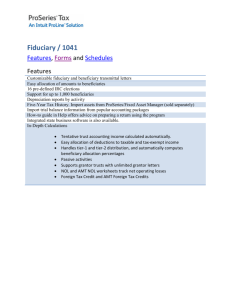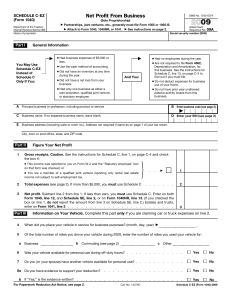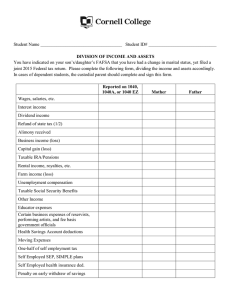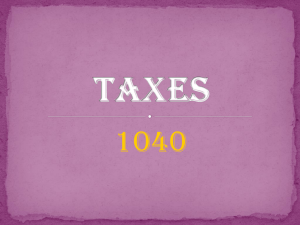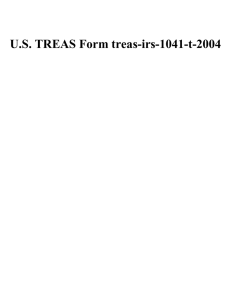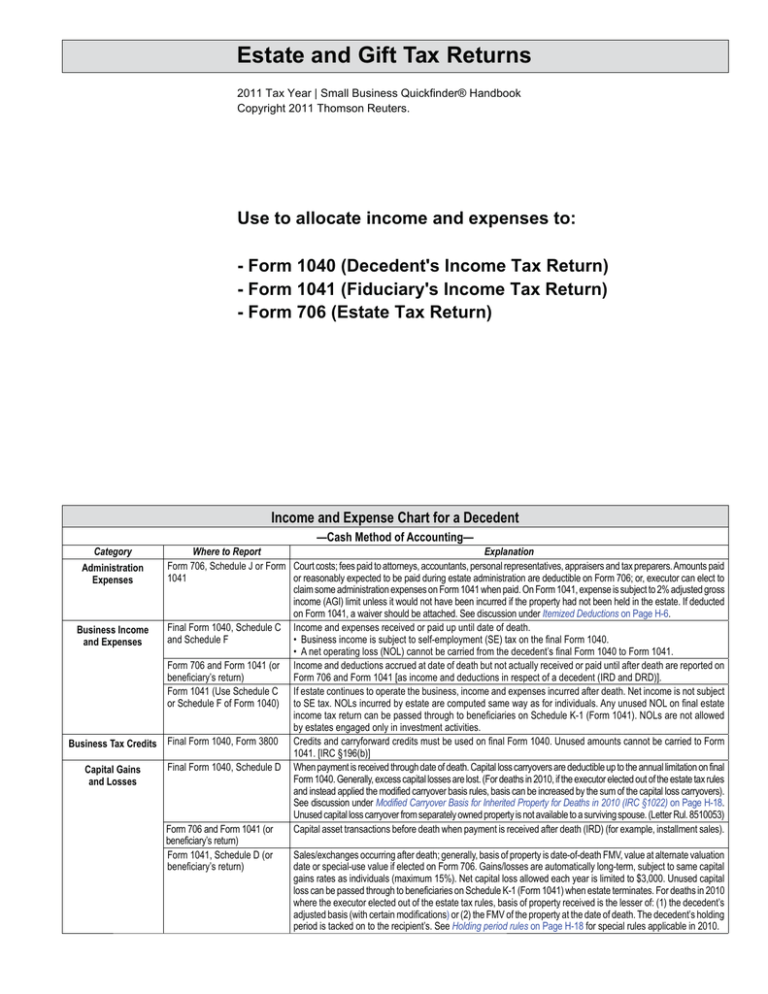
Estate and Gift Tax Returns
2011 Tax Year | Small Business Quickfinder® Handbook
Copyright 2011 Thomson Reuters.
Use to allocate income and expenses to:
- Form 1040 (Decedent's Income Tax Return)
- Form 1041 (Fiduciary's Income Tax Return)
- Form 706 (Estate Tax Return)
Income and Expense Chart for a Decedent
—Cash Method of Accounting—
Category
Where to Report
Explanation
Form 706, Schedule J or Form Court costs; fees paid to attorneys, accountants, personal representatives, appraisers and tax preparers. Amounts paid
Administration
1041
or reasonably expected to be paid during estate administration are deductible on Form 706; or, executor can elect to
Expenses
claim some administration expenses on Form 1041 when paid. On Form 1041, expense is subject to 2% adjusted gross
income (AGI) limit unless it would not have been incurred if the property had not been held in the estate. If deducted
on Form 1041, a waiver should be attached. See discussion under Itemized Deductions on Page H-6.
Final Form 1040, Schedule C Income and expenses received or paid up until date of death.
Business Income
and Schedule F
%XVLQHVVLQFRPHLVVXEMHFWWRVHOIHPSOR\PHQW6(WD[RQWKHILQDO)RUP
and Expenses
$QHWRSHUDWLQJORVV12/FDQQRWEHFDUULHGIURPWKHGHFHGHQW¶VILQDO)RUPWR)RUP
Form 706 and Form 1041 (or Income and deductions accrued at date of death but not actually received or paid until after death are reported on
beneficiary’s return)
Form 706 and Form 1041 [as income and deductions in respect of a decedent (IRD and DRD)].
Form 1041 (Use Schedule C If estate continues to operate the business, income and expenses incurred after death. Net income is not subject
or Schedule F of Form 1040) to SE tax. NOLs incurred by estate are computed same way as for individuals. Any unused NOL on final estate
income tax return can be passed through to beneficiaries on Schedule K-1 (Form 1041). NOLs are not allowed
by estates engaged only in investment activities.
Business Tax Credits Final Form 1040, Form 3800 Credits and carryforward credits must be used on final Form 1040. Unused amounts cannot be carried to Form
1041. [IRC §196(b)]
Final
Form
1040,
Schedule
D
When payment is received through date of death. Capital loss carryovers are deductible up to the annual limitation on final
Capital Gains
Form 1040. Generally, excess capital losses are lost. (For deaths in 2010, if the executor elected out of the estate tax rules
and Losses
and instead applied the modified carryover basis rules, basis can be increased by the sum of the capital loss carryovers).
See discussion under Modified Carryover Basis for Inherited Property for Deaths in 2010 (IRC §1022) on Page H-18.
Unused capital loss carryover from separately owned property is not available to a surviving spouse. (Letter Rul. 8510053)
Form 706 and Form 1041 (or
Capital asset transactions before death when payment is received after death (IRD) (for example, installment sales).
beneficiary’s return)
Form 1041, Schedule D (or
Sales/exchanges occurring after death; generally, basis of property is date-of-death FMV, value at alternate valuation
beneficiary’s return)
date or special-use value if elected on Form 706. Gains/losses are automatically long-term, subject to same capital
gains rates as individuals (maximum 15%). Net capital loss allowed each year is limited to $3,000. Unused capital
loss can be passed through to beneficiaries on Schedule K-1 (Form 1041) when estate terminates. For deaths in 2010
where the executor elected out of the estate tax rules, basis of property received is the lesser of: (1) the decedent’s
adjusted basis (with certain modifications) or (2) the FMV of the property at the date of death. The decedent’s holding
period is tacked on to the recipient’s. See Holding period rules on Page H-18 for special rules applicable in 2010.
Income and Expense Chart for a Decedent (Continued)
—Cash Method of Accounting—
Category
Where to Report
Final Form 1040
Form 706, Schedule L or Form
1041
Final Form 1040
Form 1041, Schedule A
Casualty and
Theft Losses
Charitable
Contributions
Form 706, Schedule O
Claims Against Estate Form 706, Schedule K
Credit for the Elderly Final Form 1040, Schedule R
or the Disabled
Deductions in Respect Form 706 and Form 1041 (or
of a Decedent (DRD) beneficiary’s return)
Figured as though decedent lived full year.
Business expenses, income-producing expenses, interest and taxes for which decedent was liable but which are
not deductible on final Form 1040.
Final Form 1040
Form 1041, Form 4562
Depreciation
Depreciation for period ending on date of death. Short tax year rules apply; see Tab J.
If estate continues to operate decedent’s business or rental property, depreciation is allocated between estate and
income beneficiaries (assuming estate is claiming an income distribution deduction) on basis of income allocated to
each. Estate is not allowed Section 179 deduction. Short tax year rules apply for any tax year of the estate less than 12
months. See Tab J for short tax year rules.
Dividends received through date of death.
Dividends received after date of death. Estates and trusts are subject to same reduced tax rate on qualified
dividends as individuals (15% maximum rate).
Dividends declared to shareholders of record before death, but not available or received until after death (IRD).
Final Form 1040, Schedule B
Form 1041, Schedule B (or
beneficiary’s return)
Form 706, Schedule B and
Form 1041 (or beneficiary’s
return)
Final
Form 1040, Schedule
Earned Income Credit
EIC
(EIC)
Estate Tax Deduction Form 1041 (or beneficiary’s
Form 1040, Schedule A)
Final Form 1040
Exemptions
Dividend Income
Available even if decedent’s return covers only a part year and decedent would not have qualified with a full year’s
income. A decedent’s credit is refundable.
If federal estate tax was paid on IRD, a deduction can be claimed on the income tax return that reports the IRD.
Full amount allowed for decedent; no proration required. For decedent to claim exemption of a dependent, decedent
must have furnished over one-half of support for entire year.
An estate is allowed a $600 exemption even if first return period is less than 12 months.
Allowed on Form 706, never on Form 1041 or 1040. State law generally determines which items are deductible
funeral expenses. Reg. §20.2053-2 classifies the following as funeral expenses if allowable under local law: tombstone, monument, mausoleum, burial lot for decedent or family (including costs for future care) and transportation
of the person bringing body to burial place.
Income received and expenses paid before death.
Income received and expenses paid after death, including income and expenses in respect of a decedent.
Form 1041
Form 706, Schedule J
Funeral Expenses
Income and Expenses Final Form 1040
Form 1041 (or beneficiary’s
Generally
return)
Form 706
Income in Respect of Form 706 and Form 1041 (or
beneficiary’s return)
a Decedent (IRD)
Income Tax Due on
Final Form 1040
Installment Sales
Contracts Held
by Decedent
Interest Earned
Interest Expense
H-2
Explanation
Casualties and thefts incurred before death.
Casualties and thefts during administration of estate are reported on Form 706 or, if elected, on Form 1041. If
reported on Form 1041, attach a statement that loss was not claimed on Form 706.
Amounts contributed before death. (IRC §170)
Contributions are deductible only if decedent’s will requires that contribution be made from gross taxable income
[Reg. §1.642(c)-1]. AGI limitations applicable to individuals do not apply to estates.
Value of property in decedent’s estate that was transferred by decedent (via his will) or by qualified disclaimer to
a charity described in Section 2055(a).
Enforceable personal obligations of decedent at time of death plus interest accrued up to time of death.
Income and expenses in respect of decedent (also reported on Form 1041 or beneficiary’s return).
All gross income that the decedent had the right to receive and is not includable on final Form 1040. If estate tax is
paid on this income, a deduction for estate tax paid can be claimed on the income tax return that reports income.
Form 706, Schedule K
Federal and state income taxes unpaid at date of death, including tax due on final Form 1040 prepared and filed
after death.
Final Form 1040, Form 6252
Form 706 and Form 1041 (or
beneficiary’s return)
Form 1041 (or beneficiary’s
return)
Form 706 and Form 1041 (or
beneficiary’s return) (attach
Form 6252)
Final Form 1040, Schedule B
Form 706, Schedule B and Form
1041 (or beneficiary’s return)
Form 1041 (or beneficiary’s
return)
Final Form 1040
Form 706 and Form 1041 (or
beneficiary’s return)
Form 1041 (or beneficiary’s
return)
Payments received through date of death.
If note cancels at death under decedent’s will, date-of-death value is reported on Form 706 and unrecognized gain on
Form 1041 (as IRD). If decedent and obligor are related, FMV of installment note cannot be less than its face value.
If note is self-canceling at death (a so-called self-canceling installment note or SCIN), unrecognized gain is
included on Form 1041 (as IRD).
If contract is not canceled at death, difference between face amount of obligation and decedent’s basis is reported
on Form 706 and is considered IRD [IRC §691(a)(4)]. As payments are collected, recipient reports income using
decedent’s gross profit percentage.
Interest received through date of death plus original issue discount (OID) earned through date of death.
Interest accrued but unpaid at date of death is IRD.
Interest earned and received after date of death.
Deductible interest paid before death.
Deductible interest expense accrued before death but paid after death (DRD). Nondeductible personal interest
accrued before death but paid after death is allowed as a debt of estate on Form 706, Schedule K.
Interest paid after death. Use Form 4952 for investment interest expense. Interest expense on decedent’s personal
residence is qualified residential interest only if a beneficiary uses it as a residence during estate administration
[IRC §163(h)(4)]. Otherwise, the interest is either investment interest (subject to limitations on Form 4952), rental
interest expense or nondeductible personal interest. Investment interest expense attributable to tax-exempt
income is not deductible.
Table continued on the next page
2011 Tax Year
|
Small Business Quickfinder® Handbook
Copyright 2011 Thomson Reuters. All Rights Reserved.
Income and Expense Chart for a Decedent (Continued)
—Cash Method of Accounting—
Category
IRA, SEP, SIMPLE,
Keogh, 401(k), etc.
Medical Expenses
Where to Report
Form 706, Schedule I
Final Form 1040
Form 1041 (or beneficiary’s
return)
Final Form 1040, Schedule A
Form 706, Schedule K
Miscellaneous
Itemized Deductions
Partnership Income
(Loss)
Passive Losses
Form 1041
Final Form 1040
Form 706, Schedule J or Form Unpaid miscellaneous itemized deductions at date of death are reported on Form 706. When paid, deduct on
1041
Form 1041 as DRD.
Form 1041
Incurred and paid after death: may be subject to 2% AGI limit. See Deductions on Page G-5.
Final Form 1040, Schedule E
Form 1041 (or beneficiary’s
return)
Final Form 1040
Form 1041
Personal Residence
Form 1041
Final Form 1040, Schedule A
Form 706, Schedule K and
Form 1041 (or beneficiary’s
return)
Form 1041 (or beneficiary’s return)
Final Form 1040, Schedule E
Rental Income
Form 706 and Form 1041 (or
and Expenses
beneficiary’s return)
Form 1041 (use Schedule E of
Form 1040)
S Corporation Income Final Form 1040, Schedule E
(Loss)
Real Estate,
State and Local
Income Taxes
Explanation
The account balance of all tax-deferred benefits at the time of death. Benefits are taxable to the beneficiary when
distributed (IRD). Beneficiaries can roll over IRA funds.
Amounts actually received before death.
Distributions made after death (IRD). These distributions are not subject to the 10% early withdrawal penalty.
[IRC §72(t)(2)(A)(ii)]
Medical expenses paid before death. Can elect to deduct medical expenses incurred before death but paid from the
estate within one year of the day following death [Reg. §1.213-1(d)]. Election does not apply to medical expenses
for dependents of the decedent. To elect, attach a statement to Form 1040 stating the estate has waived the right
to claim medical expense for estate tax. With the election, deduction is taken on Form 1040, Schedule A in year
costs were incurred (a Form 1040X may be needed).
Unpaid medical expenses at death are reported on Form 706 as a claim against the estate, unless an election is made
to report on decedent’s final Form 1040. Amounts deducted on Form 706 are not subject to the 7.5% AGI limitation.
If deduction taken on Form 1040, amount not allowed due to 7.5% AGI limitation cannot be claimed on Form 706.
Any insurance reimbursements after death of amounts previously deducted on Form 1040. Report as IRD.
Miscellaneous itemized deductions paid before death.
Income (or loss) up to date of death using any reasonable method of allocating income (loss). Allocation is often
based on pro rata amount for year or interim closing of books.
Income (or loss) after death not included on final Form 1040.
Losses are allowed to extent of passive income, plus accumulated unused losses to extent they exceed any
increase in basis allocated to the activity. For example, if a passive activity’s basis is increased $6,000 upon
taxpayer’s death, and unused passive activity losses as of date of death are $8,000, decedent’s deduction is
$2,000 ($8,000 – $6,000). Note there are special rules for decedents who died in 2010 and the executor elected
the modified carryover basis rules instead of the estate tax rules.
Estates are subject to the same passive loss limitation rules as individuals. The fiduciary’s level of participation
determines the classification. If decedent actively participated in a rental real estate activity before death, the
estate will be allowed the special $25,000 rental real estate exemption for up to two years after decedent’s death.
The Section 121 exclusion of gain from sale of personal residence does not apply to estates. If personal residence
is a capital asset to the estate (either held for investment or rental purposes), estate can deduct loss on sale. If
property is used by estate beneficiaries for personal purposes, loss on sale is not deductible. If home was not
subject to probate and passed directly to heirs, sale of home is reported on beneficiaries’ Form 1040. For deaths
in 2010 where the modified carryover basis is elected, allocation of basis increase to other assets may be preferable since gain may be excluded by the beneficiary.
Paid before death. General sales taxes deductible if state and local income taxes not deducted. [IRC §164(b)(5)]
Real estate taxes accrued before death but paid after death.
Accrued and paid after death.
Income and expenses received or paid before death.
Income and expenses accrued before death but not actually received or paid until after death (IRD and DRD).
Passive activity loss rules apply to estates (for Form 1041 reporting).
Income and expenses accrued and received or paid after death. Passive loss rules apply to estates.
Pro rata share of income (or loss) up to death. Generally, amount of income (or loss) is computed as follows:
S corporation income or loss for the year, divided by number of days in S corporation’s year, multiplied by number
of days shareholder was alive. Can elect under Section 1377(a)(2) to close S corporation books on day of death.
Form 1041 (or beneficiary’s return) Income (or loss) after date of death and not included on final Form 1040.
Series E or EE U.S. Final Form 1040 or Form 1041 Two options: (Rev. Rul. 68-145)
1) Executor elects to report interest accrued before death on final Form 1040. Interest accrued after death is
Savings Bond Interest
reported on Form 1041 (or beneficiary’s return) in year bond is redeemed or matures.
(Decedent did not
2) All interest (both before and after death) is reported on Form 1041 (or beneficiary’s return) in year bond
elect to report
is redeemed, matures or an election is made to report income. Interest accrued before death is IRD.
interest annually)
Alternatively, recipient of an inherited bond can elect to report interest annually. (Rev. Rul. 64-104)
Form 706, Schedule B
FMV of bonds, including interest accrued up to date of death, which may be IRD.
Interest accrued up to date of death.
Series E or EE U.S. Final Form 1040
Interest accrued after death. Note that the last Series E bonds matured in 2010 and are no longer accruing interest.
Savings Bond Interest Form 1041 (or beneficiary’s
(Decedent elected to return)
report interest annually) Form 706, Schedule B
FMV of bonds as of date of death. No IRD.
Final Form 1040
Payments cease at death; therefore, subject to reporting on final Form 1040.
Social Security
Standard Deduction
Wages
Final Form 1040
Full amount allowed. No proration required.
Final Form 1040
Wages received before death.
Form 706, Schedule F and Form Wages earned before death but received after death (IRD).
1041 (or beneficiary’s return)
2011 Tax Year
Copyright 2011 Thomson Reuters. All Rights Reserved.
|
Small Business Quickfinder® Handbook
H-3

